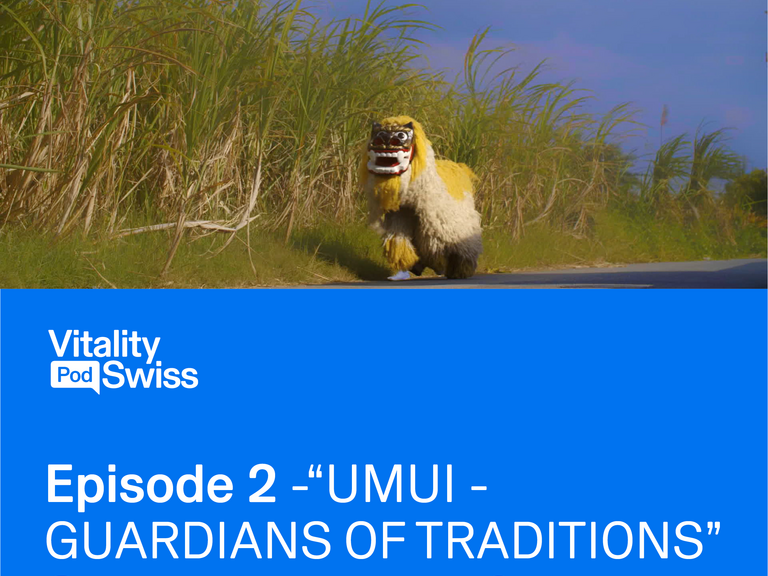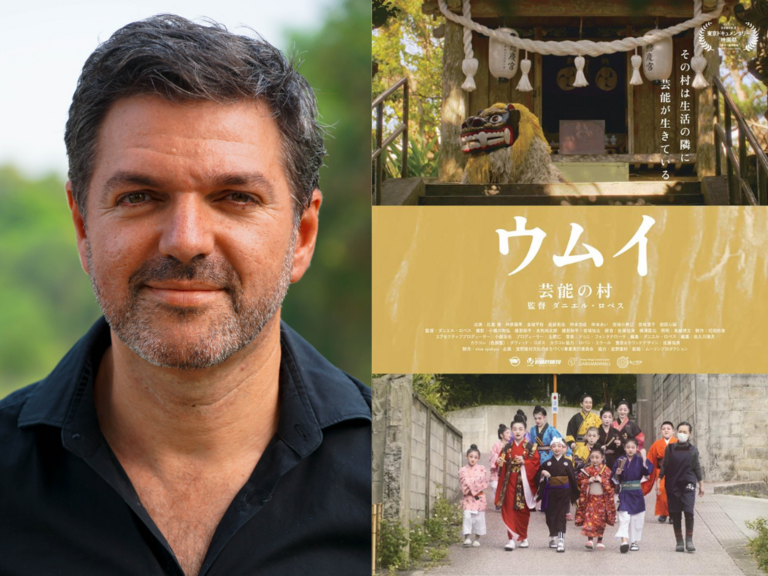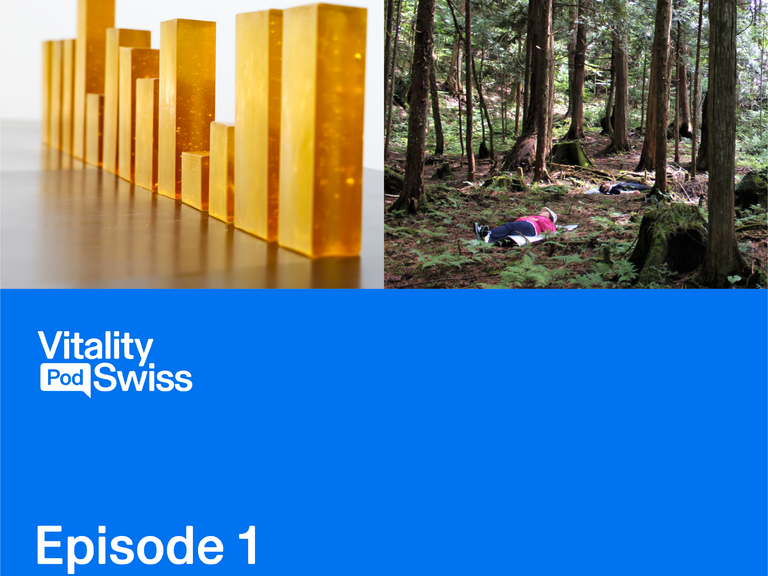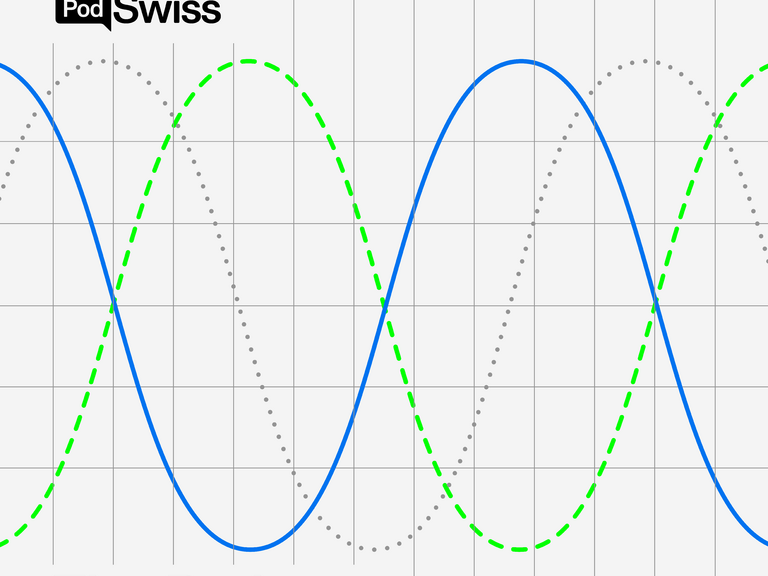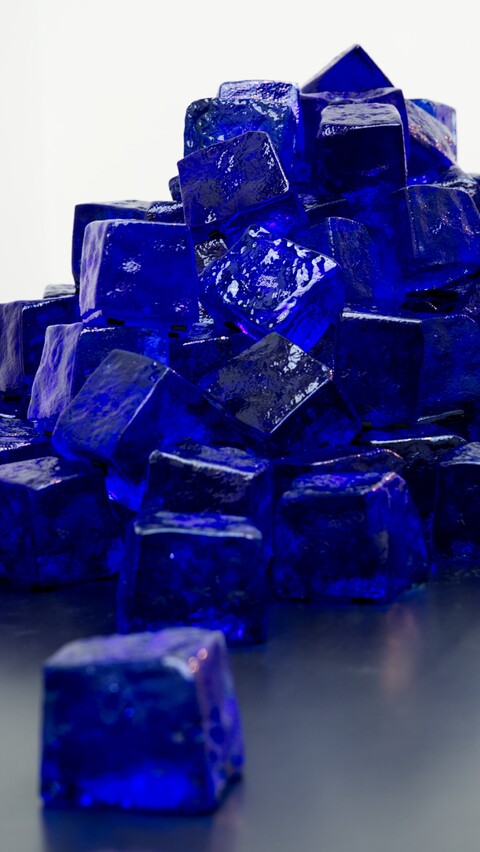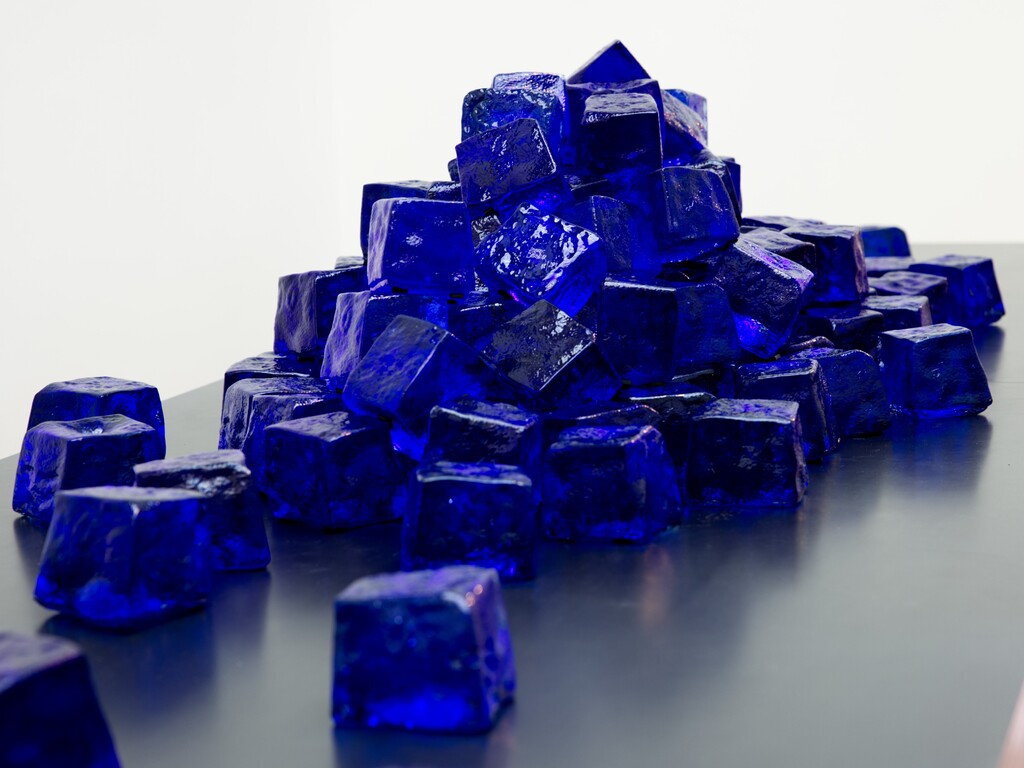Yuko:こんにちは。スイス大使館広報文化部の高橋優子です。
今日は同僚のサラ・ボックマンさんと、Vitality.Swiss Podcastのエピソード1をお届けします。さっそくですが、サラさん、今回のトピックは何ですか?
Sarah:Hi everyone! I’m Sarah Bokman and I will be one of the moderators for this first Vitality.Swiss podcast together with Yuko.
Today we have a look at the effects of art and nature on our well-being with two distinguished guest speakers.
Yuko:アートと自然を取り入れて、心身ともに健康で幸せな状態、ウェルビーイングでいるには、というお話ですね。
今日はゲストとして、スイス人アーティストで看護師のウーベル・クレボシエーさんと、
森林浴などの自然セラピーを研究されている千葉大学環境健康フィールド科学センターの宮崎良文さんにお越しいただいています。お二人の活動から、私たちのウェルビーイングを今日は学びたいと思います。ではさっそく具体的に教えていただきましょう。
Sarah:We have a Swiss artist, who previously worked as a nurse, Mr. Hubert Crevoisier from Switzerland together with us. Can I call you Hubert ?
Hubert: It’s perfect. May I call you Sarah ?
Sarah:And from the Japanese side, we have a Japanese researcher studying Shinrin-yoku (Forest Therapy) Mr. Yoshifumi Miyazaki. Could you both introduce in a few words your work, what it is you do? Maybe we can start with Hubert ?
Hubert: I’m Hubert Crevoisier. I’m a Swiss glass artist who has worked for 30 years with glass. I trained as a craftsman at the Orrefors Glass School in Sweden and I am self-taught artist. In my last solo exhibition entitled “Hubert Crevoisier. I’m blue, I’m yellow, I’m green glass … and I see red” which took place at the Ariana Museum in Geneva, the Swiss Museum of Ceramics and Glass. I created installations from glass to invite the visitor to enter a space of light and color. In order to better understand my intimate link between “art and health”, it is important to mention my second profession as a nurse in public health, which I always practiced, until 3 years ago, in parallel with my art practice. I have been working for 30 years as an artist, as a nurse and human being is at the center of my creativity.
Yuko:ウーベルさんは、ガラスを主に扱うアーティストです。スウェーデンのオレフォス・ガラススクールで学び、その後は独学で技術を磨かれました。近作では、ジュネーブのアリアナ美術館で個展「Hubert Crevoisier. I’m blue, I’m yellow, I’m green glass … and I see red」が開催されていました(2022年2月~8月)。何といっても3年前までは、公衆衛生分野の看護師でもあった、というのがウーベルさんを特徴づけるご経歴です。創作の源は人とのこと。
宮崎さんのご活動についてもお教えいただけますか?
Miyazaki-sensei:私は、森林等の自然と人との関係を解明する研究者です。現在は千葉大学の名誉教授として研究を続けています。
Sarah: Mr. Miyazaki, you are a researcher who elucidates the relationship between humans and nature, such as forests. And you are currently a professor at Chiba University.
How does your work relate to well-being or health? Hubert, would you like to start ?
Hubert: I’m not a scientist, I’m an artist. I’ve worked intuitively for 30 years. [But even if I’m unable to explain it verbally, I’m convinced there is a link between “art and health”. It’s the reason why] I postulate that “beauty heals”. When I heard that the “Montreal Museum of Fine Arts” had created an “art and health” department, I jumped on the first plane to see what was going on there. What I saw and felt in Montreal confirmed what I have been doing intuitively along my 30 years art work. I was at the right place and it’s the reason why I developed this intimating between “art and health”.
Before my exhibition in Museum Ariana, I wanted to explore deeper this link between “art and health” and I made, 2 years ago, an artistic residency at Malévoz Quartier Culturel. By working artistically with patients with disabilities or mental illness, I saw and measured the impact of creation on the well-being of the patients. In the publication presenting my residency work, it is written “Hubert is not an art therapist. He says he has explored the space of the red color. He did in Malévoz what his fellow artists do: go beyond the surface to enter the depths and explore the language of other possibilities. These are the positive effects of the work of plastic expression, it allows, for a moment, to use another language to rekindle hope, to make light and color dance in the heads and hearts of patients. “
Yuko:美は癒しであると考えていると考えているウーベルさん。科学者ではないのでその機能の説明はできないものの、30年間のご自身のアート活動を通じて、直感的にアートと健康にはつながりがあると実感していたそうです。ですから、カナダのモントリオール美術館に「アートと健康」部門ができたと聞き、すぐに駆け付けたそうです。そこで見たのは、ウーベルさんのこれまでの活動とまさに一致するものであったと。
その後ウーベルさんはアリアナ美術館で展覧会を行うのですが、この展覧会のために障害や精神疾患を持つ患者さんと一緒に芸術的な作業をしたそうです。そこで創作活動が患者さんに幸せを与える大いなる効果を体験されたそうです。
宮崎さんはいかがですか?
Miyazaki-sensei:ウーベルさんの考えに賛同します。森林浴等の自然セラピーがもたらすストレス軽減、生理的リラックス状態に関して研究しています。
Sarah:So your research focuses on nature therapy and its effects on our bodies, such as reduction in stress levels and relaxation. That’s really interesting, we talk about nature therapy and art and well-being but currently there is a lot of interest in alternative therapies and in understanding health and well-being.
Maybe we can start with you Hubert. In your latest exhibition you collaborated with medical practitioners to provide “art prescriptions”, could you tell us about that ?
Hubert: The project of museum prescription we proposed during our exhibition is the result of a long 4 years journey. From my professional experience as an artist and nurse on the one hand and the recommendations issued in 2019 by the World Health Organization (WHO) on the other hand, I took the initiative of contacting Professor Barbara Broers, a national expert for prevention and addiction, and the cultural service of the University Hospital in Geneva (HUG). I proposed to realize a pilot project “art and health” to the Ariana Museum in Geneva and the professor.
Yuko:2019年のWHOの勧告からアリアナ美術館にアートと健康をテーマとする展覧会を提案したウーベルさん。ジュネーブ大学病院の文化サービスとして、バーバラ・ブローズ教授の監修の下、科学的な監修による「アート処方箋」を大学病院の医師とジュネーブ市内の一般開業医に配布するというプロジェクトを実現させました。
Hubert: I can maybe add something. For this project with the Ariana Museum, we came up with an idea I had seeing in Montreal about “medical prescriptions”. Under scientific supervision of Professor Broers and Doctor Sittarame, experts at Geneva University Hospital, we printed “art prescriptions” as forms and we distributed them to the doctors of the University Hospital and to the general practioners in the city of Geneva to motivate them to make “medical prescriptions”. The prescriptions allowed the patients to discover the exhibition free of charge in company of a person of their choice, with or without the curator of the Musée Ariana. The evaluation of the project is still ongoing but one thing is sure, it will go further on. During the exhibition, we also invited art and health experts for a multidisciplinary conference entitled “Art and Health: A winning team? “ You can see the recording of this conference on the Ariana Museum website.
Yuko:この処方箋により、患者さんは無料で美術館を訪問して鑑賞することができたそうです。
この4年間にもわたるプロジェクト、そして行われたアートと健康の専門家による学術的なトークイベントの模様はアリアナ美術館のWEB上でご覧いただけるそうなので、ぜひご覧ください。
宮崎さん、森林浴はどうでしょうか?宮崎さんがご研究されている森林浴などの自然セラピーの目的をお教えいただけますか?
Miyazaki-sensei:はい。まず前提として、現代社会において人は、ストレス状態にあるということがあります。そこで、現代人が自然に触れるとどのような状態になるのかということを実験しています。
森林浴等の自然セラピーの目的は、「人と自然の関係」を生理的に解明することです。具体的には、脳活動、自律神経活動、ストレスホルモン等の内分泌活動、免疫活動を指標として、自然がもたらす生理的リラックス効果を科学的エビデンスとして蓄積します。
その結果、森林浴を始めとした様々な自然は、人に生理的リラックス効果をもたらすことが、科学的に明らかになりつつあります。
自然セラピーは、病気を治すことはできませんが、病気になりにくい体を作ることはできます。生理的にリラックスするとストレス状態で低下していた免疫機能が回復するからです。これを「予防医学的効果」と言います。「予防医学的効果」は、世界的に問題となっている「医療費削減」に貢献します。これが、将来的な究極の目的となります。
Sarah:That’s really fascinating. So through Shinrin-yoku or nature therapy, we try to understand the relationship between humans and nature, when we come in contact with nature and its effects on the body, in particular its relaxing properties. You’ve even found scientific evidence of this through indicators such as stress hormones and brain and immune activity. Of course it is not a cure for diseases, but it has a strengthening effect on the body as relaxation combats stress, which weakens the immune system.
It is remarkable to hear of the larger goal of reducing medical costs, through this preventative medical effect of Shinrin-yoku. Would you like to explain the concept behind Shinrin-yoku ?
Miyazaki-sensei:基盤となる考え方について、少し長くなりますが、2つの観点からお話ししますね。
まず自然と人の関係です。人は700万年間自然環境下で過ごしてきたため、我々の身体は「自然対応用」にできています。
産業革命以降、急速な都市化・人工化が進みました。しかし、遺伝子は2~300年では変化できないため、我々は自然対応用の身体を持って現代社会で生活しているため、生理的ストレス状態になっています。そしてふたつめの観点として、快適性からお話します。人は、環境とシンクロした時に快適さを感じます。これは芸術作品、森林においても同じです。ミーティングやコンサートでも同様で、シンクロし、一体化した時に快適な状況が生み出されます。「快適性」には、種類があります。不快の除去を目的とする「受動的快適性」とプラスαを目的とする「能動的快適性」です。芸術も「自然セラピー」も能動的快適性の範疇に含まれます。この快適性の特徴は、個人差が大きく、個人の好みが大きく反映されるということです。
Sarah :I see, so Shinrin-yoku can be explained through these two concepts :
Our long-standing relationship to nature and our comfort. I hadn’t thought about it but it is true that our bodies are used to a natural environment as humans have only been living in cities in the last 200-300 years. As such our bodies seek this nature and are stressed by modern society. This is a very interesting concept.
You propose a very interesting understanding of comfort. You speak of passive comfort, where we simply eliminate discomfort, such as when we are too cold or too hot, and active comfort, where we seek to gain something more, we actively seek comfort. It’s true that if we think about it art, music, and nature therapy are active comfort. We synchronize with our environment and feel comfortable. We are seeking comfort. You say this comfort is specific to each individual, what about Shinrin-yoku is there a common way of doing it or is it also personal?
Miyazaki-sensei:人は森林等の自然に触れると、「直観的に」、「自動的に」、「勝手に」、身体がリラックスするのです。これが、森林等の自然によって、人がリラックスする仕組みです。この現象は、経験的は知られているのですが、各種の生理指標を用いた生理的リラックス効果に関しては、知見がありませんでした。
1990年に日本の屋久島でストレスホルモン(コルチゾール)を用いて実験したのですが、多分、これが世界初の生理実験と思われます。また、木の嗅覚刺激が血圧低下をもたらす研究成果を1992年に報告したのですが、これが、初の木材セラピーにおける生理実験です。
最も重要なのは、どのようにして没頭するか、ということです。森への没頭の仕方は、個人によって、異なります。
重要なことは、好きな森、あるいは五感に関わる自然要素を自分で見つけ、それらとシンクロすることです。前記したように、森林浴は「受動的快適性」ではなく「能動的快適性」なのです。
自分と森が一体化したとき、「快適感」が生じ、ストレス状態が改善されます。
Sarah:So it is a very personal search for comfort. I have never thought of finding my favourite forest or element of nature that engages my senses and synchronize with them. So because it’s an “active comfort” when we become one with the forest, a sense of comfort arises and we become less stressed. Everybody knows that going for a walk in nature will brighten your mood, but we don’t really understand why. But you found evidence of this physiological relaxation effect in 1990 using the stress hormone cortisol as an indicator.
That’s really interesting and it’s true that it is the same with art. We seek out art, nature or forests, and that is active comfort.
Has there been any research done on the effect of art or nature on health and well-being? Any studies that demonstrate its efficacy?
Hubert: I am not a scientist and I have no competence to talk about scientific research. But what I can say is that the scientific studies launched by the Montreal Museum of Fine Arts were supervised by a scientific committee chaired by Mr. Rémi Quirion, first Chief Scientist of Quebec. In the meantime, in 2019, the WHO published a meta-analysis which concluded that art is beneficial to mental and physical health. The WHO report states that artistic practices have a direct impact on the health of patients, especially when there is a personal involvement in the creation. The WHO now recommends that arts and cultural activities should be integrated into health care programs. I recently discovered that a new research institution of international importance has been created in Switzerland on this subject of “culture and health”: the Swiss Center for Design and Health located in Bienne. https://scdh.ch/en/
Yuko:ご自身は科学者ではないので、ご自身で芸術とウェルビーイングに与える影響を証明はできないと前置きされたウーベルさん。カナダのモントリオール美術館ではケベック州の初代主任研究員であるRemi Quirion (レミ・キリオン)教授が率いる科学委員会がその研究をしていること、そして、WHOでは、芸術が心身の健康に有益であると結論づけたメタ分析を発表していることを教えてくれました。
そして、スイスでもSwiss Center for Design and Health – SCDH(デザインと健康のためのスイスセンター)が設立されたそうです。この「デザインと健康のためのスイスセンター」は、2019年にスイス連邦政府とベルン州、研究機関と民間企業によって設立されたスイスの研究機関です。
宮崎さんは、自然が健康や幸福に与える影響とその効果を科学的に証明したことで、有名でいらっしゃいますね。少しご説明いただけますか?
Miyazaki-sensei:私も今お話しがあったように自然セラピーとアートセラピーというのは、根本は一緒だと考えています。ぜひ私自身でも実験してみたいテーマだと思っています。今まで森林浴あるいは自然セラピー関係でやっていたことで分かったこととしては、非常に大型の研究を日本の森でやったのです。63箇所の森林でやる。そうすると脳もリラックスするし、体も自律神経活動という副交感神経活動と交感神経活動をはかりますけれども。その結果から見ても体自身が生理的にリラックスするということが分かりました。これが一つです。
さらに面白いことは、一日の9時から15時まで、6時間、森林セラピープログラムを高血圧の方々に参加して、行ってもらいました。終わったら血圧が低下するのですが、会社に戻った後も、この効果が5日間継続することが分かりました。
もう一つ最後に、これ非常に重要なことですけれども、よく血圧が高い人の話というのが話題になるけども、血圧が低すぎる人も大きな問題です。森林浴で分かったことは森林浴によって高い人は下がって、低い人は上がることを分かりました。「生体調整効果」ということですね。これが自然が持っている最も大きな効果ではないか、これをこれから明らかにして行きたいと思っています。
森林浴実験に関しては、2つのタイプの実験を実施しました。
1)14年間に亘り、日本中の63箇所の森林と比較のための都市にて、768名を対象に実験しました。15分間の「歩行」と「座って見る」という実験です。
2)9時から15時まで、森林内で様々なプログラムを実施するという「1日タイプ」実験も10箇所ほどの森林で実施しています。
その結果、以下の3つの知見が得られました。
1)15分間の森林浴によって、都市部に比べて、
①ストレスホルモン(コルチゾール)濃度が低下すること
②リラックス時に高まる副交感神経活動が亢進すること
③ストレス時に高まる交感神経活動が低下すること
④血圧と心拍数が低下すること
⑤脳前頭前野活動が鎮静化すること
が分かり、身体が生理的にリラックスしました。
2)高血圧者を対象とした「1日タイプ」実験において、
①血圧が低下すること
②血圧の低下は、日常生活に戻った後、5日間継続すること
が分かりました。
3)森林浴には「生体調整効果」があることが分かりました。
①血圧の高い人においては、低下し、血圧の低い人においては、上昇し、
②適正値に近づけるという「生体調整効果」があることが分かりました。
Sarah:Yes, I think we can all agree that’s a very interesting topic, not only regarding Shinrinyoku but also art. Everybody knows that going for a walk in nature will brighten your mood, but we don’t really understand why. But you found evidence of this physiological relaxation effect through your experiments. You also found that this effect lasts, that after experiencing Shinrinyoku the effect lasted for 5 days. That’s quite interesting. I should definitely go into the forest more so I can have less stress.
Regarding the outcome of Shinrinyoku, you not only found that it reduces stress through relaxation but can also help with blood pressure, not only for people with high blood pressure by lowering it but also for people with low blood pressure by raising it. The body will adjust itself to its best state. It’s interesting because we always think about high blood pressure but not often about low blood pressure.
Already in 1990 you found evidence of this physiological relaxation effect using the stress hormone cortisol as an indicator. So you conducted two types experiments: a 15-minute walk and a sit and watch experiment. What you found was that it reduces stress, blood pressure and the body became physiologically relaxed or adjusted to a better state.
Concerning the shinrin-yoku experiment, two types of experiments were conducted.
1) A 15-minute “walk” and “sit-and-watch” experiment involving 768 participants was conducted over 14 years in 63 forests throughout Japan and cities for comparison purposes.
2) A “one-day type” experiment, in which various programs are conducted in the forest from 9:00 am to 3:00 pm, has also been conducted in about ten experiments.
The results yielded the following three findings
(1) 15 minutes of shinrin-yoku, compared to urban areas,
1) Stress hormone (cortisol) levels decrease.
2) Parasympathetic nervous activity, which increases during relaxation, is enhanced.
3) Sympathetic nervous activity, which increases during stress, decreases.
4) Blood pressure and heart rate decrease.
5) Prefrontal cortex activity is calmed.
The body became physiologically relaxed.
2) In a “one-day type” experiment with hypertensive subjects
1. Blood pressure decrease.
2. The decrease in blood pressure continued for five days after returning to daily life.
3) It was found that shinrin-yoku has a “physiological adjustment effect.”
1. It lowers blood pressure in people with high blood pressure and raises blood pressure in people with low blood pressure
2. it has the “physiological adjustment effect” of bringing blood pressure to the proper level.
As a Japanese researcher what do you think of this idea of doctors prescribing visits to museums? Could it be implemented in Japan?
Miyazaki-sensei:(科学者として医者が美術館訪問を処方するというアイデアは)良いアイデアだと思います。
一方、芸術も森林浴も「能動的快適性」です。興味のない人には、プラスを生み出しません。芸術に興味のある人、好きな人を対象に実施するのが良いと思います。日本では、本件に関して、ある程度の科学的エビデンスが蓄積された場合、可能になるかも知れません。
Sarah:It’s true that in the case of “active comfort” people need that have an interest in the topic for there to be any effect. If people aren’t interested in art or forests, then you cannot ensure the same outcome, the same relaxation. We need to conduct this project with people interested in art. Then we will wait for scientific evidence to be gathered in Japan as well, to see if it can be implemented.
Hubert, do you think that this forest therapy could also be implemented in Switzerland?
Hubert: I’ve never been to Japan but I recently discovered a Japanese Forest at the Swiss National Arboretum. Mr. Sylvain Meier, a swiss forest engineer created in 1970/ 1980 this Japanese forest in the Valley of Aubonne. I participated there in a 3 days course of initiation to the techniques of natural dyeing which included a walk in the Japanese forest, a botanical introduction and a collection of materials to be used for dyeing. The artist who conducted the course took us, in the heart of Switzerland, into the visible and invisible colors of a Japanese forest. And it’s true, I felt a deep relaxation at the end of this 3 days course.
By doing a quick search on Internet, I discovered that Shinrinyoku is already present in Switzerland. There is already a lot about Forest Bathing. I discover that there is an association in Switzerland for Shinrinyoku, there is a Shinrinyoku training and a list of Shinrinyoku therapists. So I was surprised that there were already many things happening in Switzerland.
Links:
https://www.aoocolours.com/stage-en-suisse
https://www.syds.ch
https://www.waldbaden-akademie.ch
https://www.dialog-n.ch/waldbaden.html
Yuko:ウーベルさん、日本にいらしたことはまだないそうなのですが、なんとスイスにはシルヴァン・マイヤー(Sylvain Meier)さんが1970年から80年にかけてヴォ―州、オーボンヌの谷に作った「日本の森」があることを教えてくれました。そこでウーベルさんは森の散策、植物学的な紹介や染色に使用する材料の収集などを含む3日間の天然染色の入門コースを受けたそうです。スイスの中心で、日本の森の見える色と見えない色の中に参加者たちを連れて行ってくれたと、そして、この3日間のコースが終わったとき、深いくつろぎを感じたそうです。
そして、ウーベルさん、インターネットで森林浴についても調べてくださいました!
そしたら何と、スイスには森林浴協会があって、森林浴のトレーニングや森林浴セラビストのリストもあるということ。スイスではすでに、森林浴が行われていたのですね。
宮崎さんの著書「SHINRINYOKU」はスイスのOrell Füssliという出版社からというドイツ語でも出版されていますね。
私たちは、ウェルビーイングや瞑想についてよく話題にしますが、宮崎さんがお考えになる能動的、受動的な 健康・ウェルビーイングな状態とはどのような関係があるのでしょうか?
Miyazaki-sensei:瞑想も自然セラピーも能動的快適性の範疇です。瞑想も、ストレス軽減に関して、有効だと思われますので、自分の好みに応じて、実施すれば良いと思います。
一方、自然セラピーの場合、人の身体が自然対応用に出来ています。そのため、「勝手に」ストレス軽減効果、リラックス効果が生じますので、瞑想や他のセラピーに比べて、大きなアドバンテージを持っていると考えます。
Sarah:Thank you for your explanation on the relationship between active and passive comfort, or states of health and wellbeing. So while meditation is considered effective for stress reduction, the body will automatically relax in the case of nature therapy, as it is designed to respond to nature. That’s fascinating. I definitely need to go in nature more. Especially if my body is going to do it on its own and I don’t need to do anything. So nature therapy has a significant advantage over other therapies.
How does well-being, contemplation relate to active or passive well-being and health in your opinion, Hubert?
Hubert: In my last exhibition I did at the Museum Ariana, I worked as every glassmaker has been working since the dawn of time by placing glass in every church, cathedral, temple, mosque and palace in the world. In this last exhibition I have not only shown beautiful pieces of glass. But I have invited the visitor of the exhibition to immerse himself in a space of light and colors.
The idea behind it was to offer the visitor the opportunity to see, to perceive and to feel how the color yellow transforms the colour blue into green. Using words to explain a process of human transformation is impossible for me. You have to do it, you can maybe see, feel or you can experience it. But I’m convinced that you can measure it scientifically.
Yuko:ウーベルさんは、訪問者を光と色彩の空間に没入させるような展覧会を最近、開催したそうです。黄色が青や緑に変化していく様子を見て、感じてもらう機会を提供したかった、
それで言葉では説明しにくい、人間の変容のプロセスを体験してもらいたかったと。
Hubert: To my intuitive point of view, a visit to a museum doesn’t “heal” really but it brings a state of relaxation because it allows, for a moment, to disconnect from the system of cognitive thought based on “competition, performance and efficiency ” to reconnect to another sensorial system of thought based on “perception, intuition and emotion”.
Yuko:ウーベルさんが思うには、美術館にいくと「癒される」というのは競争やパフォーマンス、効率といった思考から離れて、「知覚、直感、感情」に基づく別の思考システムに再び接続することができるからじゃないのかな、とおっしゃっています。同意される方も多いのではないでしょうか。
それでは、最後に、日常生活に取り入れることのできる、健康で幸せな、ウェルビーイングであるためにおすすめのことがありましたら、教えてください。
まずは宮崎さん、お願いします。
Miyazaki-sensei:自然セラピーに関して述べると、自分とシンクロする自然を探すことです。
精油、花、庭、木材、公園、森林等のサイズや使い方の異なる自然が身の回りには沢山あります。自分の状況や体調に応じて、自分で能動的に選択し、シンクロできると快適感、幸福感は向上すると思います。
Sarah: So it is important to synchronize with our environment, to feel it, to better understand it. And even if we cannot express it through words, it is possible to do so through feelings. Be it for nature or art. Thank you for your recommendations for our daily lives ! So it is finding the right nature for us that will synchronize with us ! It can even be an element of nature such as essential oils, flowers, gardens, woods, parks, forests, etc. By actively choosing and synchronizing with this element, depending on our situation and physical condition, our sense of comfort and well-being will improve.
What about you Hubert?Do you have any recommendations to promote well-being that can be adopted in our everyday lives?
Hubert: That was a very difficult question. In attempting to answer, I had to come back to the skills I developed as an artist working with light and colours and as nurse who worked on a concept of global health. Research shows that cultivating a caring attitude toward oneself and others is beneficial to health and social relationships. Today, I strongly believe in the benefits of commitment to a cause, to a dream, to a passion. We need to dream today. One thing I know for sure: Engaging myself in art as I did in the las 30 years, reconnected me to myself and to the world. So …how can a person, a community or a society cultivate a caring attitude? If I had continued my work as a nurse, I think that today, in my prevention interviews, I would ask my patients the following question: how can you become the Red Cross of yourself?
Yuko:ウーベルさんは、ウェルビーイングであるためには、ご自分のアーティスト・看護師としての出発点を考えてみたいと。自分自身や他人を思いやることが、健康で社会的な人間関係にとても重要ということは研究結果でも示されています。ウーベルさんがご自分で、間違いなく確かなのは、夢や情熱にコミットすることがすごく必要であるということ、だそうです。
ウーベルさんは、この30年アートに没頭することで、世界とのつながりを取り戻したそうです。
どうやって人は、地域は、社会は、思いやりを育てることができるのか…
もしウーベルさんが看護師としての仕事を続けていたら患者さんにこう問いかけるそうです
「あなた自身の赤十字にどうしたらあなたはなれますか?」と。思いやりをもって人や社会と関わりあっていく、そういうことがご自分の、そして社会のウェルビーイングにつながっていくのではないか、ということですね。
ウーベルさん、宮崎さん、本日はありがとうございました。
Sarah:Thank you Hubert, thank you Miyazaki-sensei it was great to have you with us.
Hubert: You as well Sarah. Thank you too, thank you Japan, thank you Tokyo, thank you Mr. Miyazaki and Sarah. It was a pleasure to spend this time with you.
Yuko:今日のトピックはいかがでしたか?ご意見ご感想をぜひお聞かせください。
それから、もしみなさんのお薦めのリラックス方法などがあればぜひ教えてくださいね。
ご意見などは、私たち、在日スイス大使館のfacebook、Instagram、TwitterやLinkedInなどのソーシャルメディアのメッセージ機能を使ってお送りください。なお、これらのアカウントは、Vitality.Swissの websiteからアクセスいただけますので、どうぞご確認ください。
それでは、次回のポッドキャストもどうぞお楽しみに!またお会いするのを楽しみにしています。
Sarah:Thank you very much for listening to us today! We hope you liked today’s topic and we would love to hear from you! Don’t hesitate to let us know your thoughts on this episode and share with us what is your method of relaxation. You can get in contact through our social media channels, Facebook, Instagram, Twitter, or LinkedIn.
You can find all the information we mentioned on the web page on the Vitality.Swiss website with related links! Don’t hesitate to check it out and stay tuned for the next Vitalty.Swiss Podcast!
参考文献・関係リンク
“Culture and Health”: the Swiss Center for Design and Health located in Bienne. https://scdh.ch/en/
https://www.syds.ch
https://www.waldbaden-akademie.ch
https://www.dialog-n.ch/waldbaden.html
